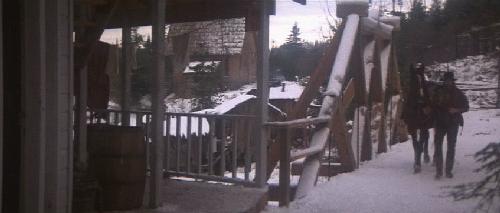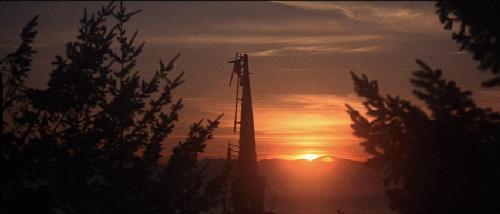McCabe & Mrs Miller (Robert Altman), 1971)
When Robert Altman made McCabe & Mrs Miller, he wasn’t the stereotypical New Hollywood director. In his mid forties, with many years in the industry (obscure B-pictures in the fifties, and television throughout the sixties), he was an emerging talent but still a product of the system. Yet McCabe & Mrs Miller is nevertheless classic New Hollywood: it takes an established Hollywood genre and deconstructs it; it focuses on amoral (or at least non-heroic) protagonists; it’s downbeat; and it’s photographed and constructed more like a European art film than American genre films typically had been until that point. You can see why canon-building critics like Pauline Kael, eager to welcome in a new wave of filmmakers, flipped for it. Kael wasn’t wrong – it is a great film. Yet I think it’s worth another look because the response to it is very telling about the way audiences and critics respond to the collision of art and genre.
I’ve written before, in reference to more commercial films like Rocky or Spielberg’s first few films, about the knack Hollywood films had in the seventies for combining genre narratives with art film aesthetics. McCabe is “artier” than those other examples, but it demonstrates the same basic formula. It is built on very simple, archetypal western elements: a frontiersman challenged by the corruption of encroaching civilization; the whore with the heart of gold holding her place in a world of men; the eventual showdown with the hired killers. Around these elements Altman fashions a film based on atmosphere and character rather than narrative. Visually, the emphasis is on beautiful realism: it looks pretty, but compared to a conventional western it’s a messier, dirtier sort of prettiness that insists on the genuineness of its locations. (The decision to shoot chronologically and build the sets during the shoot, to correspond to the growth of the town of Presbyterian Church, strongly reinforces the sense of the town as a real place; it is as close to neo-realist location shooting as a period film can get). Altman’s famous sound design – which emphasises semi-improvised overlapping dialogue, recorded live on set as much as possible – serves a similar effect. This is coupled with a use of long zoom lenses to “pick out” actors from crowded scenes, an effect that is self-conscious but which magnifies the effect of eavesdropping on real conversations. Instead of an orchestral score, the music is anachronistic contemporary songs by Leonard Cohen (although I suspect these seem less out of place to those seeing the film today; perhaps as long as the music has some patina of “oldness” about it, we don’t quibble about whether the period matches).
As well as these stylistic touches, Altman picks at the genre narrative to aid in its deconstruction. The simple storyline is presented haphazardly, with major events (such as the commencement of the romance between McCabe and Mrs Miller) happening offscreen, while other long sequences serve mood but no obvious story purposes. The main protagonist, Warren Beatty’s John McCabe, is an ambiguous and unheroic figure. The villains take a long time to turn up, and their initial representatives are comical and unthreatening. Even when the heavies turn up, Altman continues with little jokes: as the main gunman says he is in town to shoot bears, McCabe is dressed in an enormous fur coat that is practically a bear costume. The approach to the western’s core theme, the encroachment of corrupting civilization, is cynical in a countercultural sort of way. Not only is McCabe himself no angel, but when he faces off against the forces that seek financial control of the town, the townsfolk are oblivious to the confrontation. The citizens of the town are too preoccupied saving the symbols of moral fortitude (the burning church) to mount any resistance to the amoral forces taking control of their town. And the ending is downbeat, with McCabe dead in a snowdrift as Mrs Miller sits in an opium haze.
These qualities placed the film firmly within the new tradition of New Hollywood: the film particularly closely resembles Arthur Penn’s Bonnie and Clyde (which also starred Beatty) which is as neat a starting point for the movement as one could find. That Altman slots in so neatly to a film movement mostly made up of younger directors speaks of the way that the stars aligned for Altman in this period. His younger contemporaries had the good fortune to emerge from film school just as crumbling movie studios were desperate to try anything in its quest to connect with a youth audience. Altman was even more fortunate, however, benefiting from the concurrence of this shift in the studios with the technical advancements that made his signature style possible. Altman’s unique approach to dialogue and sound design, which had come to fruition a year before in MASH, was made possible by advancements in multi-channel recording and mixing of sound that had occurred at the end of the sixties. Film critics often seem to see art and technology as competing imperatives; advances in sound technology are of interest only for big blockbuster movies, and of little relevance to film as art. Altman’s case is the perfect reminder of what a technology-driven form cinema is, and how art and technology go hand in hand. The ability to record and mix complex overlapping dialogue has effects on other aspects of his technique, freeing up performances, blocking, and camerawork to allow the improvisational feel that Altman’s work is so famous for.
Which isn’t to say the chaotic, hard-to-discern sound of McCabe doesn’t have its detractors. Beatty hated it, feeling Altman had pushed a style which worked in MASH too far. Even the film’s editor, Lou Lombardo, has said it was poorly recorded and compared its sound to an out-of-focus picture. Certainly the film treads a fine line; not being able to hear every word adds has its own inherent realism, but at the same time missing things tends to take you out of the experience. (Pauline Kael wrote that “it takes a while to realise that if you didn’t hear someone’s words it’s all right,” which sounds like a rationalisation to me.) But perhaps having something that is a borderline stuff-up work anyway is part of what makes a great director great. When I saw Altman’s final film, A Prairie Home Companion, I kept thinking that nobody else would get away with the slapdash construction Altman did there, and I still haven’t made up my mind whether that’s a testament to Altman or an indictment of critical double standards. In McCabe, however, the case for greatness is clearer cut. The sound, considered on its own, might not work, but as I’ve said it makes possible other aspects of Altman’s technique that definitely do: improvisation, realism, and atmosphere. These qualities give the film life and character, and McCabe & Mrs Miller is a beautiful mood piece that creates an almost trance-like effect.
Stepping back from my admiration of the film for a moment, however, it’s also the case that these techniques serve another purpose. We recognise these as the traits of an art film, giving us permission to take this genre film seriously. Altman professed that the story of McCabe didn’t interest him, deriding the clichés and calling the original script “one of the worst Western stories you’ve ever heard.” The fact that he instead focuses on those aspects of the film we consider respectable confirms its status as a proper art western, and allows raves such as Kael’s not to seem silly and misplaced.
Yet I wonder if Altman didn’t undervalue the importance of his genre framework, and if critics sometimes respond more to the disreputable elements of a film like this than they care to admit. One of the film’s most remembered sequences is that in which a killer guns down an innocent man on a bridge. It’s a brilliantly played scene, chilling in its effect, and possibly the film’s best. It’s also pure genre filmmaking. It doesn’t illuminate character (except to establish this guy as pure evil – in other words, a stock villain), or deconstruct the genre, or offer any social commentary. Similarly, the film closes with an extended gunfight between McCabe and hired killers that is expertly staged and choreographed by Altman, who uses the familiarity with the township’s geography that we have gained throughout the film to great effect. You won’t often hear Altman’s expert staging of an action climax singled out in commentary of the film. Yet how watchable would the film be if it didn’t lead up to this catharsis? If McCabe ran away, or the gunfight lasted only twenty seconds, would the film be as remembered, and as praised for all the other elements that came before? My hunch is that if the story hadn’t been resolved with the violence the genre demands, the film would have been criticised as a lot of pretty pictures that amounted to nothing (much as I suspect nobody would have liked MASH without the big comic climax of the football game.)
It might be argued that these aspects of the film are Altman’s concession to the studio, basically a hook to get his film made and do the other things that he was really interested in. Here’s the thing, though: sure, I love the arty stuff, but for me those two scenes I’ve cited are the best parts of the movie. It could be that I’m a genre retard, unable to enjoy the more sophisticated stuff without the simple pleasures of people shooting each other. But I suspect I’m not alone in feeling this way, and you only have to look to a film like Heaven’s Gate to see what happens to a beautiful-looking art western where the nuts and bolts of story don’t work. In arguing this, I’m also not suggesting that the genre elements are a kind of delivery system for art, helping to keep us awake so that we can ingest the actual good stuff. Such a “sugar and medicine” view doesn’t do justice to something like McCabe, or many other New Hollywood examples, where the genre and art elements work in such harmony. While a New Hollywood film such as McCabe is a vastly different film to a seventies genre film like Rocky, at a formal level the two have a surprising amount in common. New Hollywood saw the best of European art cinema folded in within American traditions, and we’re misunderstanding what these films did if we attribute all their greatness to only one half of that pedigree.

